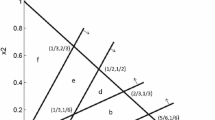Abstract
The pooling problem is an extension of the minimum cost flow problem defined on a directed graph with three layers of nodes, where quality constraints are introduced at each terminal node. Flow entering the network at the source nodes has a given quality, at the internal nodes (pools) the entering flow is blended, and then sent to the terminal nodes where all entering flow streams are blended again. The resulting flow quality at the terminals has to satisfy given bounds. The objective is to find a cost-minimizing flow assignment that satisfies network capacities and the terminals’ quality specifications. Recently, it was proved that the pooling problem is NP-hard, and that the hardness persists when the network has a unique pool. In contrast, instances with only one source or only one terminal can be formulated as compact linear programs, and thereby solved in polynomial time. In this work, it is proved that the pooling problem remains NP-hard even if there is only one quality constraint at each terminal. Further, it is proved that the NP-hardness also persists if the number of sources and the number of terminals are no more than two, and it is proved that the problem remains hard if all in-degrees or all out-degrees are at most two. Examples of special cases in which the problem is solvable by linear programming are also given. Finally, some open problems, which need to be addressed in order to identify more closely the borderlines between polynomially solvable and NP-hard variants of the pooling problem, are pointed out.



Similar content being viewed by others
References
Adhya, N., Tawarmalani, M., Sahinidis, N.V.: A Lagrangian approach to the pooling problem. Ind. Eng. Chem. Res. 38(5), 1965–1972 (1999)
Alfaki, M., Haugland, D.: Strong formulations for the pooling problem. J. Glob. Optim. 56(3), 897–916 (2013)
Al-Khayyal, F.A., Falk, J.E.: Jointly constrained biconvex programming. Math. Oper. Res. 8(2), 273–286 (1983)
Almutairi, H., Elhedhli, S.: A new Lagrangian approach to the pooling problem. J. Glob. Optim. 45(2), 237–257 (2009)
Audet, C., Brimberg, J., Hansen, P., Le Digabel, S., Mladenović, N.: Pooling problem: alternate formulations and solution methods. Manag. Sci. 50(6), 761–776 (2004)
Baker, T.E., Lasdon, L.S.: Successive linear programming at Exxon. Manag. Sci. 31(3), 264–274 (1985)
Ben-Tal, A., Eiger, G., Gershovitz, V.: Global minimization by reducing the duality gap. Math. Program. 63(1–3), 193–212 (1994)
DeWitt, C.W., Lasdon, L.S., Waren, A.D., Brenner, D.A., Melham, S.: OMEGA: an improved gasoline blending system for Texaco. Interfaces 19(1), 85–101 (1989)
Dey, S., Gupte, A.: Analysis of MILP techniques for the pooling problem. Oper. Res. 62(2), 412–427 (2015)
Floudas, C.A., Visweswaran, V.: A global optimization algorithm (GOP) for certain classes of nonconvex NLPs: I. Theory Comput. Chem. Eng. 14(12), 1397–1417 (1990)
Foulds, L.R., Haugland, D., Jörnsten, K.: A bilinear approach to the pooling problem. Optimization 24, 165–180 (1992)
Galan, B., Grossmann, I.E.: Optimal design of distributed wastewater treatment networks. Ind. Eng. Chem. Res. 37(10), 4036–4048 (1998)
Garey, M.R., Johnson, D.S.: Computers and Intractability: A Guide to the Theory of NP-Completeness. W.H. Freeman, New York (1979)
Garey, M.R., Johnson, D.S., Stockmeyer, L.: Some simplified NP-complete graph problems. Theor. Comput. Sci. 1, 237–267 (1976)
Gupte, A., Ahmed, S., Dey, S., Cheon, M.: Pooling problems: an overview. In: Furman, K., Song, J. (eds.) Optimization and Analytics in the Oil and Gas Industry, International Series in Operations Research and ManagementScience. Springer, Berlin (2015)
Haverly, C.A.: Studies of the behavior of recursion for the pooling problem. ACM SIGMAP Bull. 25, 19–28 (1978)
Haverly, C.A.: Behavior of recursion models—more studies. ACM SIGMAP Bull. 26, 22–28 (1979)
Kallrath, J.: Solving planning and design problems in the process industry using mixed integer and global optimization. Ann. Oper. Res. 140(1), 339–373 (2005)
Kohli, R., Krishnamurti, R., Mirchandani, P.: The minimum satisfiability problem. Discrete Math. 7, 275–283 (1994)
McCormick, G.P.: Computability of global solutions to factorable nonconvex programs: Part 1—Convex underestimating problems. Math. Program. 10(1), 147–175 (1976)
Misener, R., Floudas, C.A.: Advances for the pooling problem: modeling, global optimization, and computational studies. Appl. Comput. Math. 8, 3–22 (2009)
Misener, R., Floudas, C.A.: Global optimization of large-scale generalized pooling problems: quadratically constrained MINLP models. Ind. Eng. Chem. Res. 49, 5424–5438 (2010)
Misener, R., Thompson, J.P., Floudas, C.A.: APOGEE: global optimization of standard, generalized, and extended pooling problems via linear and logarithmic partitioning schemes. Comput. Chem. Eng. 35, 876–892 (2011)
Sahinidis, N.V., Tawarmalani, M.: Accelerating branch-and-bound through a modeling language construct for relaxation-specific constraints. J. Glob. Optim. 32(2), 259–280 (2005)
Visweswaran, V., Floudas, C.A.: Computational results for an efficient implementation of the GOP algorithm and its variants. In: Grossmann, I.E. (ed.) Global Optimization in Chemical Engineering, pp. 111–153. Kluwer, Dordrecht (1996)
Acknowledgments
This article was written while the author was visiting Department of Computer Architecture, University of Málaga, Spain. Invitation and support from Prof. Eligius M.T. Hendrix are gratefully acknowledged.
Author information
Authors and Affiliations
Corresponding author
Rights and permissions
About this article
Cite this article
Haugland, D. The computational complexity of the pooling problem. J Glob Optim 64, 199–215 (2016). https://doi.org/10.1007/s10898-015-0335-y
Received:
Accepted:
Published:
Issue Date:
DOI: https://doi.org/10.1007/s10898-015-0335-y




